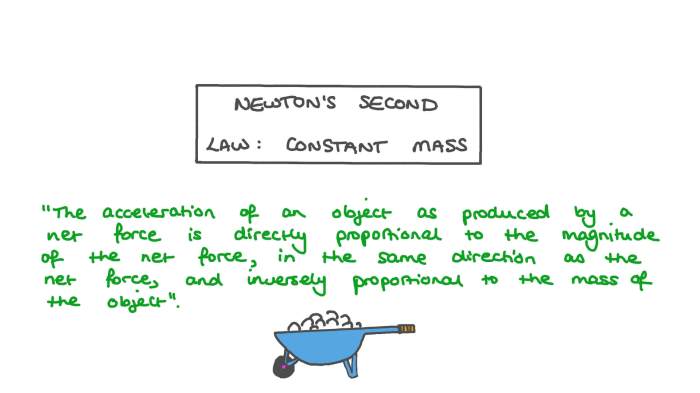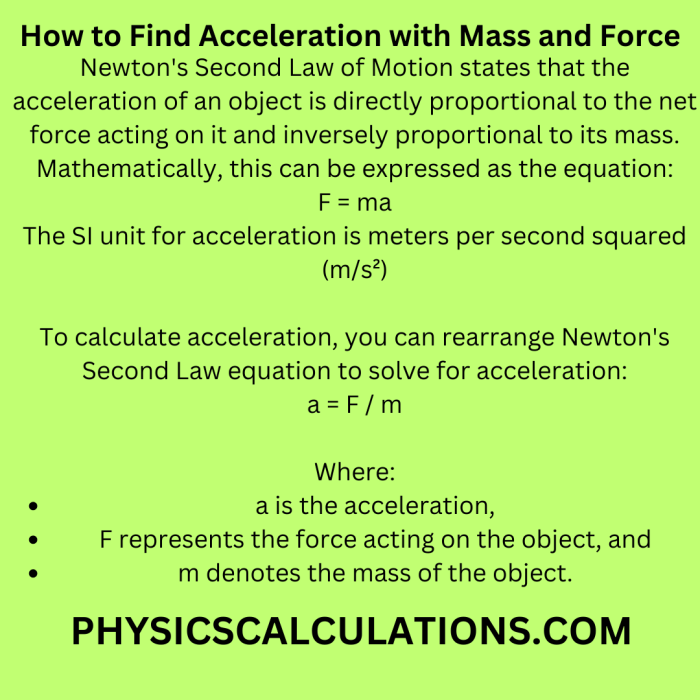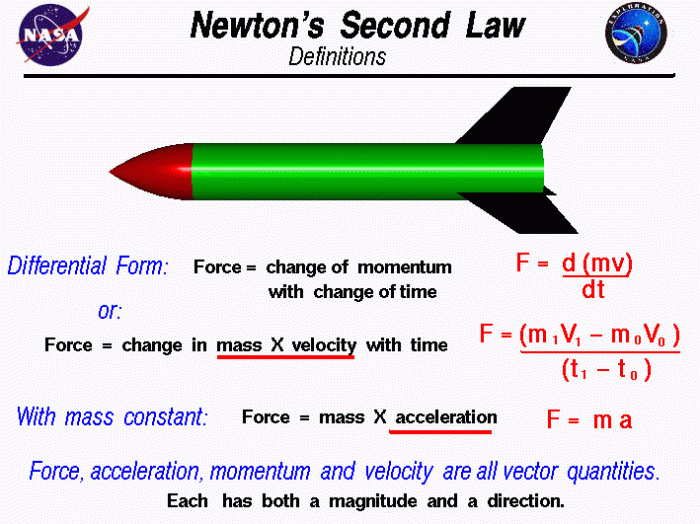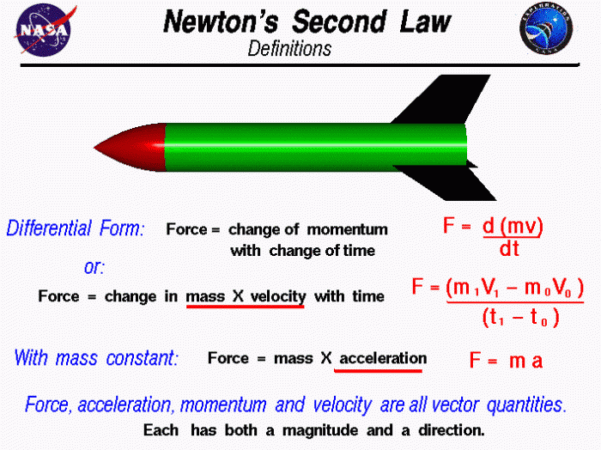
What is newtons 2nd law – What is Newton’s 2nd Law of Motion? This fundamental principle of physics, discovered by Sir Isaac Newton, describes the relationship between force, mass, and acceleration. It’s a cornerstone of classical mechanics, explaining how objects move in response to forces acting upon them. From everyday experiences like pushing a cart to the complex workings of rockets and bridges, Newton’s 2nd Law plays a vital role in understanding the physical world around us.
Newton’s 2nd Law states that the acceleration of an object is directly proportional to the net force acting on it and inversely proportional to its mass. This means that a larger force will produce a greater acceleration, while a heavier object will accelerate less for the same force. The mathematical representation of this law is F = ma, where F is the net force, m is the mass, and a is the acceleration.
Newton’s Second Law of Motion
Newton’s Second Law of Motion is a fundamental principle in physics that describes the relationship between an object’s mass, acceleration, and the force acting upon it. It states that the acceleration of an object is directly proportional to the net force acting on it and inversely proportional to its mass. This means that a greater force will result in a greater acceleration, while a larger mass will result in a smaller acceleration.
This law is essential for understanding how objects move in the universe and has numerous applications in various fields, including engineering, aerospace, and everyday life.
Historical Context and Significance
Newton’s Second Law was first formulated by Sir Isaac Newton in his groundbreaking work, *Philosophiæ Naturalis Principia Mathematica*, published in 1687. It was a pivotal discovery that revolutionized our understanding of motion and laid the foundation for classical mechanics. Before Newton, the concept of force and motion was not well-defined, and explanations for why objects moved were often based on philosophical ideas rather than scientific principles. Newton’s Second Law provided a precise mathematical framework for describing and predicting motion, which had profound implications for science and technology.
Mathematical Representation of Newton’s Second Law
Newton’s Second Law is expressed mathematically as:
F = ma
where:
* F represents the net force acting on an object (measured in Newtons (N)).
* m represents the mass of the object (measured in kilograms (kg)).
* a represents the acceleration of the object (measured in meters per second squared (m/s²)).
This equation implies that the force required to accelerate an object is directly proportional to its mass and acceleration. For example, if you double the force acting on an object, you will double its acceleration. Similarly, if you double the mass of an object, you will halve its acceleration.
Key Concepts and Definitions

Newton’s Second Law of Motion is a fundamental principle in physics that describes the relationship between force, mass, and acceleration. It provides a mathematical framework for understanding how objects move in response to applied forces. To fully grasp this law, it’s essential to understand the core concepts it encompasses.
Force
Force is a push or pull that can change the motion of an object. It is a vector quantity, meaning it has both magnitude and direction. The magnitude of a force is measured in units of Newtons (N).
- Contact forces: These forces result from the direct interaction between objects. Examples include pushing a box, friction between surfaces, and the tension in a rope.
- Non-contact forces: These forces act on objects even when they are not in direct contact. Examples include gravity, magnetism, and electrostatic forces.
Mass
Mass is a measure of the amount of matter an object contains. It is a scalar quantity, meaning it only has magnitude. The standard unit for mass is the kilogram (kg).
- Inertia: Mass is closely related to inertia, which is the tendency of an object to resist changes in its motion. The greater the mass of an object, the more inertia it has.
Acceleration
Acceleration is the rate of change of velocity. It is a vector quantity, meaning it has both magnitude and direction. The magnitude of acceleration is measured in units of meters per second squared (m/s²).
- Positive acceleration: An object is accelerating in the same direction as its velocity.
- Negative acceleration: An object is decelerating, meaning it is slowing down in the opposite direction of its velocity.
Relationship Between Force and Acceleration
Newton’s Second Law states that the acceleration of an object is directly proportional to the net force acting on it and inversely proportional to its mass. This can be represented mathematically as:
F = ma
where:
- F is the net force acting on the object
- m is the mass of the object
- a is the acceleration of the object
This means that:
- Direct proportionality: If the net force acting on an object increases, its acceleration will increase proportionally, assuming the mass remains constant. For example, if you double the force applied to an object, you will double its acceleration.
- Inverse proportionality: If the mass of an object increases, its acceleration will decrease proportionally, assuming the net force remains constant. For example, if you double the mass of an object, you will halve its acceleration.
Inertia
Inertia is the tendency of an object to resist changes in its motion. It is a fundamental property of matter and is directly related to mass. The more massive an object is, the more inertia it has, and the harder it is to change its motion.
- Rest: An object at rest will remain at rest unless acted upon by a net force. This is because its inertia keeps it stationary.
- Motion: An object in motion will continue to move at a constant velocity unless acted upon by a net force. This is because its inertia keeps it moving at a constant speed and direction.
Applications of Newton’s Second Law: What Is Newtons 2nd Law
Newton’s Second Law of Motion, often expressed as F = ma, is a fundamental principle in physics that governs the motion of objects. It describes the relationship between the force applied to an object, its mass, and the resulting acceleration. This law has numerous applications in various fields, from everyday life to complex engineering designs.
Everyday Applications
Newton’s Second Law is evident in countless everyday situations. When you push a shopping cart, you apply a force to accelerate it. The harder you push (greater force), the faster the cart accelerates. Similarly, if you throw a ball, the force you exert determines the ball’s acceleration and the distance it travels.
Calculating Force
Newton’s Second Law can be used to calculate the force required to accelerate an object. Consider a scenario where you need to move a heavy box across a floor. Let’s say the box has a mass of 50 kg, and you want to accelerate it at a rate of 2 m/s². Using the formula F = ma, we can calculate the required force:
F = (50 kg) × (2 m/s²) = 100 N
Therefore, you would need to apply a force of 100 Newtons to accelerate the box at 2 m/s².
Engineering and Physics Applications
Newton’s Second Law plays a crucial role in engineering and physics. Engineers use this law to design structures like bridges and buildings, ensuring they can withstand the forces acting upon them. For instance, when designing a bridge, engineers must consider the weight of the bridge itself, the load it will carry, and the forces exerted by wind and traffic. Newton’s Second Law helps them calculate the necessary strength and materials for the bridge to remain stable.
In the field of rocket science, Newton’s Second Law is essential for calculating the thrust required to launch a rocket into space. The force generated by the rocket’s engines must be greater than the force of gravity to overcome Earth’s gravitational pull and propel the rocket upwards.
Examples and Illustrations

To understand how Newton’s Second Law of Motion plays out in real-world scenarios, let’s explore some examples.
Real-World Examples of Newton’s Second Law
Newton’s Second Law describes the relationship between force, mass, and acceleration. To illustrate this relationship, let’s consider a few everyday examples:
| Object | Force | Acceleration | Description |
|---|---|---|---|
| A car | The force of the engine | The car accelerates forward | When you press the gas pedal in a car, the engine exerts a force that causes the car to accelerate. The greater the force, the greater the acceleration. |
| A ball | The force of a kick | The ball accelerates in the direction of the kick | When you kick a ball, you apply a force to it. This force causes the ball to accelerate in the direction of the kick. The harder you kick the ball, the greater the force, and the greater the acceleration. |
| A person on a swing | The force of gravity | The person accelerates downwards | When you are on a swing, the force of gravity pulls you downwards. This force causes you to accelerate downwards, reaching maximum speed at the bottom of the swing. |
| A rocket | The force of the rocket engines | The rocket accelerates upwards | Rocket engines produce a powerful force that pushes the rocket upwards. This force overcomes the force of gravity, causing the rocket to accelerate into space. |
Newton’s Second Law and Motion

Newton’s Second Law of Motion is a fundamental principle in physics that describes the relationship between force, mass, and acceleration. It is a powerful tool for understanding and predicting the motion of objects in various scenarios. This law forms the foundation of classical mechanics, enabling us to analyze and explain the motion of objects in our everyday world.
Linear Motion and Newton’s Second Law, What is newtons 2nd law
Newton’s Second Law provides a direct connection between force and the resulting change in an object’s motion, specifically its acceleration. This law states that the acceleration of an object is directly proportional to the net force acting on it and inversely proportional to its mass. This means that a larger force will produce a larger acceleration, while a larger mass will result in a smaller acceleration for the same force.
The mathematical representation of Newton’s Second Law is: F = ma, where:
F represents the net force acting on the object,
m is the mass of the object, and
a is the acceleration of the object.
This equation reveals that force and acceleration are directly proportional, meaning that if you double the force, you double the acceleration. Conversely, if you double the mass, you halve the acceleration.
Explaining Motion in Different Directions and Speeds
Newton’s Second Law explains how objects move in different directions and at different speeds by considering the direction and magnitude of the force applied.
* Direction of Motion: The direction of the acceleration is the same as the direction of the net force acting on the object. For example, if you push a box to the right, the box will accelerate to the right. If you pull the box to the left, it will accelerate to the left.
* Speed of Motion: The magnitude of the acceleration is determined by the magnitude of the net force and the mass of the object. A larger force will result in a larger acceleration, causing the object to change its speed more rapidly. Conversely, a smaller force will result in a smaller acceleration, leading to a slower change in speed.
Applications of Newton’s Second Law in Real-World Scenarios
Newton’s Second Law finds wide-ranging applications in various fields, including:
* Engineering: Engineers use Newton’s Second Law to design and analyze structures, vehicles, and machines. For example, they use it to calculate the forces that act on a bridge or the acceleration of a car.
* Sports: Athletes use Newton’s Second Law to improve their performance. For example, a sprinter uses the force generated by their legs to accelerate their body, while a golfer uses the force of the club to accelerate the golf ball.
* Space Exploration: The principles of Newton’s Second Law are crucial for launching rockets, maneuvering spacecraft, and understanding the motion of celestial bodies.
Examples of Newton’s Second Law in Action
* Pushing a Cart: When you push a shopping cart, you exert a force on it, causing it to accelerate. The heavier the cart, the less it accelerates for the same force applied.
* Throwing a Ball: When you throw a ball, you exert a force on it, causing it to accelerate. The harder you throw, the greater the acceleration and the farther the ball travels.
* Stopping a Car: When you apply the brakes in a car, you exert a force that opposes the car’s motion, causing it to decelerate. The stronger the brakes, the faster the car will decelerate.
* Orbiting Satellites: Satellites orbit the Earth due to the force of gravity. The gravitational force acting on the satellite is responsible for its acceleration, keeping it in orbit.
Further Exploration and Applications
While Newton’s Second Law is a fundamental principle in classical mechanics, it has limitations and applications that extend beyond its core definition. Understanding these nuances provides a deeper understanding of its power and its limitations.
Limitations of Newton’s Second Law
Newton’s Second Law is a powerful tool for understanding motion in everyday scenarios. However, it has limitations when applied to extreme situations or very small scales.
- Relativistic Effects: At speeds approaching the speed of light, Newton’s Second Law breaks down. Special relativity dictates that mass increases with velocity, altering the relationship between force, mass, and acceleration. For instance, a spacecraft traveling at a significant fraction of the speed of light would experience a different acceleration than predicted by Newton’s Second Law.
- Quantum Mechanics: At the atomic and subatomic level, quantum mechanics governs the behavior of particles. Newton’s Second Law, which is based on classical mechanics, does not accurately describe the motion of particles at these scales. For example, the position and momentum of an electron cannot be simultaneously determined with absolute certainty, as described by Heisenberg’s Uncertainty Principle.
- Non-Inertial Frames: Newton’s Second Law applies only to inertial frames of reference, which are frames that are not accelerating. In non-inertial frames, such as a rotating carousel, additional forces, known as fictitious forces, must be considered. These forces arise from the acceleration of the frame itself, not from any interaction with other objects.
Momentum and its Connection to Newton’s Second Law
Momentum is a fundamental concept in physics that describes the mass in motion. It is defined as the product of an object’s mass and its velocity:
Momentum (p) = mass (m) × velocity (v)
Newton’s Second Law can be expressed in terms of momentum. The rate of change of momentum of an object is equal to the net force acting on it.
Force (F) = Δp / Δt
This formulation highlights the intimate connection between force and momentum. Applying a force to an object changes its momentum, causing it to accelerate or decelerate.
Analyzing Complex Systems
Newton’s Second Law can be applied to analyze the motion of complex systems involving multiple interacting particles. This involves applying the law to each individual particle and then considering the forces between them.
- Collision Dynamics: Newton’s Second Law is crucial for understanding collisions. By applying the law to each object involved in a collision, we can determine the changes in momentum and energy of the objects before and after the collision. This allows us to predict the final velocities and directions of motion of the objects involved.
- Multi-body Systems: In systems with multiple interacting bodies, such as planets orbiting a star or a system of interconnected springs and masses, Newton’s Second Law can be applied to each individual body. The forces between the bodies, such as gravitational forces or spring forces, are then included in the equations of motion. Solving these equations allows us to predict the motion of the entire system over time.
Ending Remarks
Newton’s 2nd Law of Motion is a powerful tool for understanding and predicting the motion of objects. It has countless applications in various fields, from engineering to physics, helping us design structures, calculate trajectories, and analyze the behavior of complex systems. By grasping the core concepts of force, mass, and acceleration, we gain a deeper understanding of the fundamental principles that govern the movement of objects in our universe.
Key Questions Answered
What are some real-world examples of Newton’s 2nd Law in action?
Imagine pushing a shopping cart. The harder you push (greater force), the faster it accelerates. Conversely, if the cart is full of groceries (greater mass), it will accelerate slower for the same force applied. Another example is throwing a ball. The force you exert on the ball determines its acceleration and the distance it travels.
How does Newton’s 2nd Law relate to momentum?
Momentum is a measure of an object’s mass in motion. It’s directly related to Newton’s 2nd Law, as the change in momentum of an object is equal to the impulse applied to it. Impulse is the product of force and time, so a larger force applied for a longer time will result in a greater change in momentum.
Does Newton’s 2nd Law apply to all objects?
While Newton’s 2nd Law is a fundamental principle, it has limitations. It applies primarily to objects moving at speeds much less than the speed of light. At very high speeds, relativistic effects become significant, and Einstein’s theory of relativity provides a more accurate description of motion.





